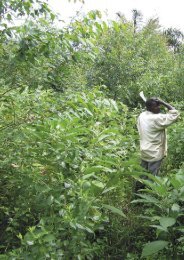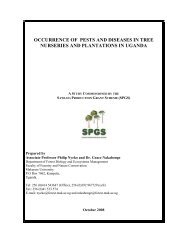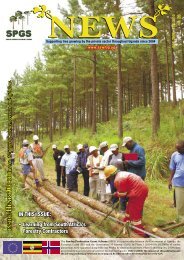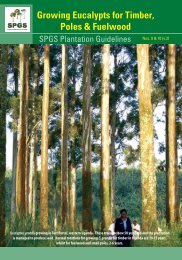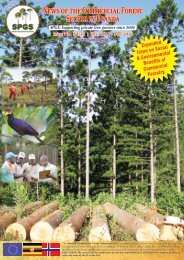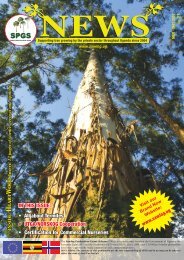Create successful ePaper yourself
Turn your PDF publications into a flip-book with our unique Google optimized e-Paper software.
SAWLOG PRODUCTION GRANT SCHEME - SEPT - NOV. 2010. ISSUE NO. 29<br />
Fig. 5: Plywood imports and exports<br />
3,000,000<br />
2,500,000<br />
2,000,000<br />
1,500,000<br />
1,000,000<br />
500,000<br />
-<br />
Import Values<br />
(CIF; USD)<br />
Import Quantities<br />
(kg)<br />
2007<br />
2008 2009<br />
Export Values<br />
(FOB; USD)<br />
Export Quantities<br />
(kg)<br />
MARKET NEWS FROM<br />
AROUND THE WORLD<br />
Thanks to NORSKOG’s Arné Rørå for this information.<br />
BIOMASS now generates 32% of all energy in Sweden.<br />
Biomass energy has now surpassed oil to become the number<br />
one source for energy generation in Sweden. The increased<br />
competition for logs and wood chips between the pulp industry<br />
and energy sector has pushed wood fibre prices to new highs.<br />
In local currency (Swedish krona), pulpwood prices in Q1<br />
2010 were almost 20% higher than five years ago.<br />
(Source: UBOS, based on URA data, 2010)<br />
The construction sector index (CSI) is calculated by the Uganda<br />
Bureau of Statistics (UBOS) based on a monthly survey. The<br />
CSI is comprised of building materials and labor costs in<br />
the construction sector and is calculated for six different<br />
project types. Timber is included only in the construction of<br />
houses (residential buildings constructed i) privately or ii) by<br />
construction companies and iii) non-residential buildings).<br />
Across these three timber and wood products contribute with<br />
9.9% to the actual building.<br />
Fig. 6 shows the development of the CSI for timber since 2008.<br />
While it does not indicate changes in volume or provides prices<br />
for different wood products, it can serve as an indicator of the<br />
overall price trend for timber since 2006 (the base year). After<br />
a sudden increase in prices at the end of 2008 prices for timber<br />
used in the construction sector have remained stable. The<br />
discrepancy to retail prices (which showed a strong downward<br />
trend in early 2009) may be caused by an increase in volume<br />
of timber used for construction, due to lower prices. Ultimately<br />
the CSI can only serve as broad long term indicator but is not<br />
likely to show smaller or short lived changes in the timber<br />
market.<br />
NB. Editor’s note: we are planning to publish this market report<br />
every 3 months in <strong>SPGS</strong> News. Let us know what you think of the<br />
information provided here and what you would like to see in future<br />
reports.<br />
Fig. 6: Timber in the Construction Sector Index<br />
CSI<br />
250<br />
200<br />
150<br />
100<br />
50<br />
0<br />
Q1<br />
1% 0%<br />
Q2<br />
34%<br />
13% 0% 0% 0% 1%<br />
Q3 Q4 Q1 Q2 Q3 Q4 Q1<br />
2008 2009 2010<br />
The percentage above each column shows the increase of timber<br />
prices in comparison to the period before. (Source: UBOS, 2009,<br />
2010)<br />
GLOBAL SAWLOG PRICES are up 17% over the past 12<br />
months, with the biggest gains seen in Northern Europe and<br />
Oceania.<br />
EUCALYPTUS LOG prices in Brazil have gone up 25% in the<br />
past year. Demand for Eucalyptus logs has increased in some<br />
regions in Brazil not only from pulp and panel manufacturers,<br />
but also from sawmills that are producing timber from both<br />
pine and Eucalyptus for the construction market. The Brazilian<br />
pulp industry consumes some 45% of harvested Eucalyptus<br />
logs, while an estimated 48% is used for fuelwood and for<br />
making charcoal for the steel industry. A growing but still<br />
small consumer of Eucalyptus logs is the sawmilling sector,<br />
that in 2009 used around 4% of the total log harvest.<br />
QUOTATION<br />
“We are drowning in a sea of information<br />
but are starved for knowledge”<br />
John Naisbitt (US Business writer; 1929-)<br />
FEEDBACK<br />
“Thanks to you and your team for the Tree<br />
Planting Guidelines: it is a big resource for<br />
contractors!<br />
Joseph Ikwap (Contractor: All Round Foresters).<br />
“Thank you very much for the arrangement<br />
of the workshop in Masindi (August 2010)<br />
and several plantations in Luwero. Also<br />
thank all the staff who were so helpful and<br />
took their time to explain to us everything<br />
carefully”<br />
(Olama Marino).<br />
“Thank you for the latest Newsletter. We<br />
are always happy to read <strong>SPGS</strong> News as the<br />
articles are very useful to Green Resources<br />
staff here in Tanzania. We are discussing<br />
possible contributions from our forestry<br />
operations in Tanzania: something will<br />
happen in the near future!”<br />
(Mwaniki Ngibuini).<br />
NEWS OF UGANDA’S COMMERCIAL TREE PLANTING FUND FOR THE PRIVATE SECTOR<br />
23



